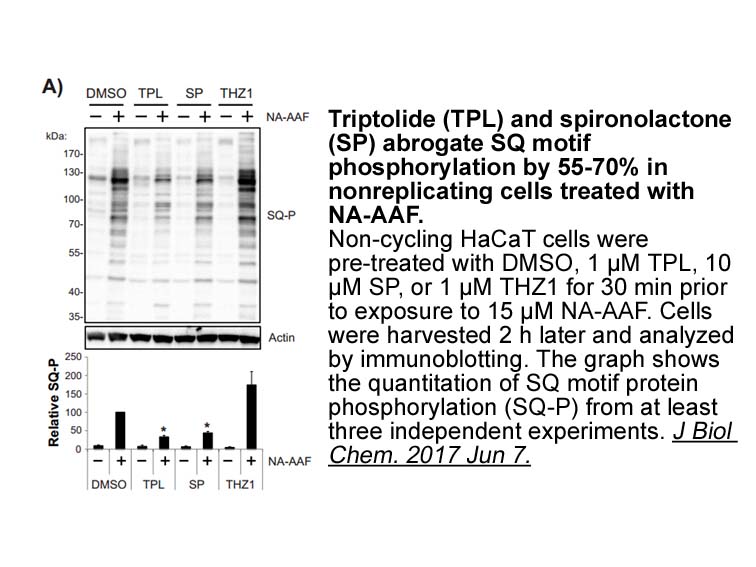Archives
br Introduction Hepatic ischemia reperfusion IR i http
Introduction
Hepatic ischemia/reperfusion (IR) i njury, which is characterized by interruption of the hepatic blood supply and subsequent re-establishment of blood flow, is a common consequence of various clinical situations, such as liver transplantation, trauma, shock, and resection of intrahepatic tumors. Hepatic IR can cause graft dysfunction, poor function, or even graft failure after liver transplantation [1,2]. Furthermore, hepatic IR injury also causes injury in the distant organs. For example, acute kidney injury has been observed in rats with hepatic IR injury [3]. Hence, an effective measure against hepatic IR injury is needed.
The mechanism of hepatic IR injury is complex, and a variety of factors underlie the mechanism. It has been commonly considered that the hepatic IR injury is triggered by the activation of Kupffer cells. The Kupffer TAK-285 are activated, then produce a variety of inflammatory factors, such as tumor necrosis factor (TNF)-α, interleukin (IL)-1β, IL-6, interferon (IFN)-γ, and reactive oxygen species (ROS) [4]. Activated Kupffer cells also accumulate and activate neutrophils, thereby aggravating the inflammatory hepatic injury. As a result, proteins involved in cell apoptosis are activated and hepatocytes die during hepatic IR.
Apoptosis, type I programmed cell death, is considered to be involved in the pathogenesis of various liver diseases, such as autoimmune hepatitis [[5], [6], [7], [8], [9], [10]] and hepatocellular carcinoma [11,12]. Apoptosis is activated by a variety of extrinsic or intrinsic pathways factors. Previous research has shown that hepatocyte necrosis and apoptosis occur during hepatic IR injury [4,13]. Furthermore, it has been shown that downregulation of hepatocyte apoptosis exerts a protective effect on hepatic IR injury [1].
Autophagy is also called type II programmed cell death [14]. Autophagy is an evolutionarily-conserved, self-digesting process which promotes cell survival by lysosomal digestion [15]; however, overactivated cell autophagy results in cell death. Autophagy is involved in the pathologic processes of a number of diseases, involving hepatic IR injury. Wu et al. [1] found that quercetin significantly attenuates hepatic IR injury by inhibiting autophagy.
Levo-tetrahydropalmatine (L-THP) is an active component of the traditional Chinese medicine, Corydalis yanhusuo. L-THP has been used in China for many years as an anxiolytic and sedative in clinics [16].
In recent years, L-THP has shown the potential to treat organ IR injury. Han et al. [17] reported that L-THP could exert protective functions on myocardial IR injury by inhibiting the production of proinflammatory cytokines, including TNF-α and myeloperoxidase (MPO), and alleviating cardiomyocyte apoptosis. Mao et al. [18] showed that L-THP attenuates blood-brain barrier injuries in mice focal cerebral IR injury model; however, the effects of L-THP on hepatic IR injury remain unknown.
njury, which is characterized by interruption of the hepatic blood supply and subsequent re-establishment of blood flow, is a common consequence of various clinical situations, such as liver transplantation, trauma, shock, and resection of intrahepatic tumors. Hepatic IR can cause graft dysfunction, poor function, or even graft failure after liver transplantation [1,2]. Furthermore, hepatic IR injury also causes injury in the distant organs. For example, acute kidney injury has been observed in rats with hepatic IR injury [3]. Hence, an effective measure against hepatic IR injury is needed.
The mechanism of hepatic IR injury is complex, and a variety of factors underlie the mechanism. It has been commonly considered that the hepatic IR injury is triggered by the activation of Kupffer cells. The Kupffer TAK-285 are activated, then produce a variety of inflammatory factors, such as tumor necrosis factor (TNF)-α, interleukin (IL)-1β, IL-6, interferon (IFN)-γ, and reactive oxygen species (ROS) [4]. Activated Kupffer cells also accumulate and activate neutrophils, thereby aggravating the inflammatory hepatic injury. As a result, proteins involved in cell apoptosis are activated and hepatocytes die during hepatic IR.
Apoptosis, type I programmed cell death, is considered to be involved in the pathogenesis of various liver diseases, such as autoimmune hepatitis [[5], [6], [7], [8], [9], [10]] and hepatocellular carcinoma [11,12]. Apoptosis is activated by a variety of extrinsic or intrinsic pathways factors. Previous research has shown that hepatocyte necrosis and apoptosis occur during hepatic IR injury [4,13]. Furthermore, it has been shown that downregulation of hepatocyte apoptosis exerts a protective effect on hepatic IR injury [1].
Autophagy is also called type II programmed cell death [14]. Autophagy is an evolutionarily-conserved, self-digesting process which promotes cell survival by lysosomal digestion [15]; however, overactivated cell autophagy results in cell death. Autophagy is involved in the pathologic processes of a number of diseases, involving hepatic IR injury. Wu et al. [1] found that quercetin significantly attenuates hepatic IR injury by inhibiting autophagy.
Levo-tetrahydropalmatine (L-THP) is an active component of the traditional Chinese medicine, Corydalis yanhusuo. L-THP has been used in China for many years as an anxiolytic and sedative in clinics [16].
In recent years, L-THP has shown the potential to treat organ IR injury. Han et al. [17] reported that L-THP could exert protective functions on myocardial IR injury by inhibiting the production of proinflammatory cytokines, including TNF-α and myeloperoxidase (MPO), and alleviating cardiomyocyte apoptosis. Mao et al. [18] showed that L-THP attenuates blood-brain barrier injuries in mice focal cerebral IR injury model; however, the effects of L-THP on hepatic IR injury remain unknown.